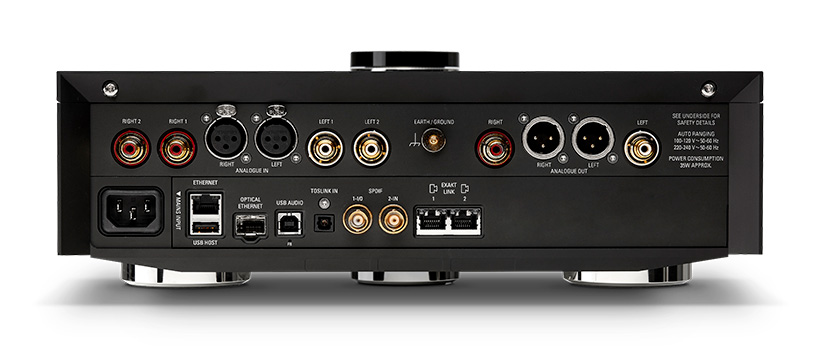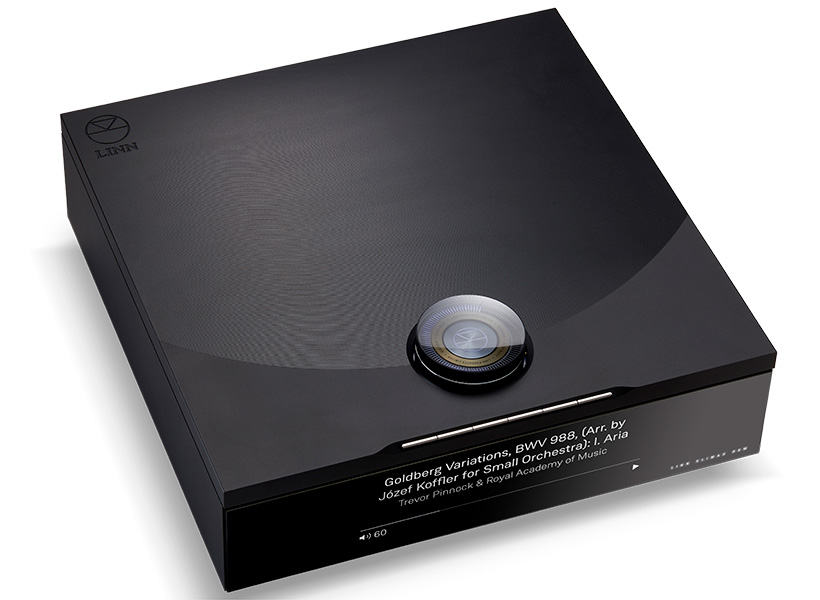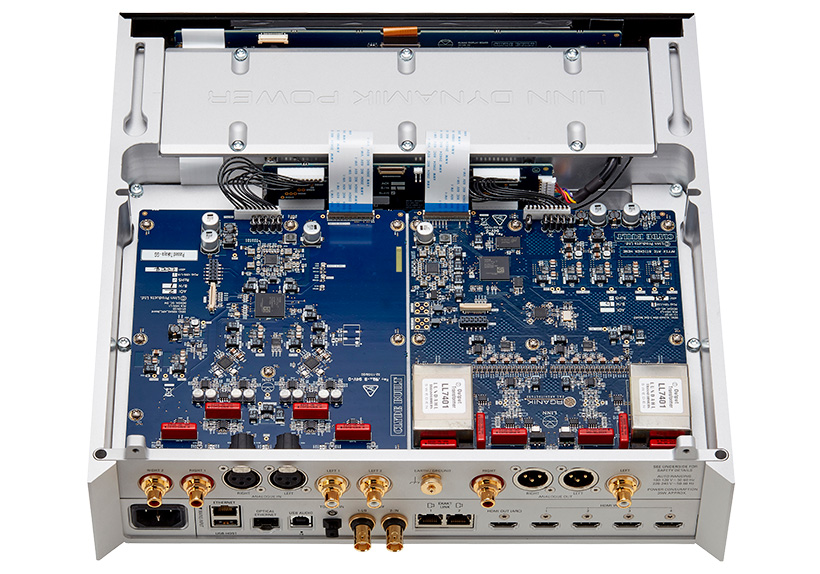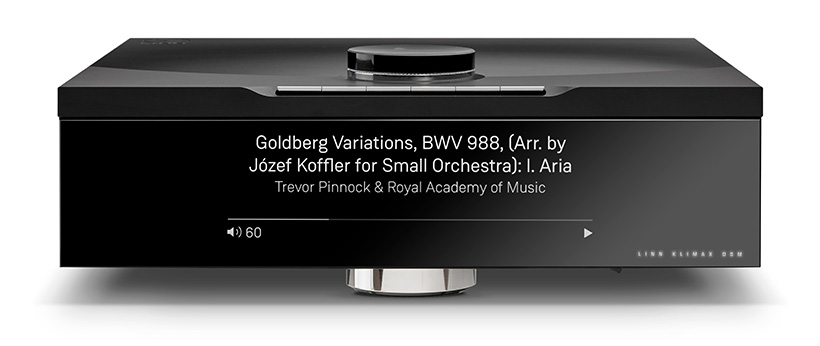Linn is one of the few hi-fi manufacturers that makes its own metalwork in house, this is because the company’s founder worked at his father’s engineering business before creating the legendary LP12 turntable and discovered a way to make a mark on the audio world. This is possibly why the latest incarnation of Linn’s ultimate streamer weighs more than any other that I’ve encountered. That and the fact that weight equates to high end appeal in no uncertain terms.
The Klimax DSM/3 is over 16 kilos of engineering and electronics that is superbly executed with diamond cut grooves in the top to emulate a vinyl record. It’s a more substantial piece of kit than its relatively slim predecessor and contains an element that few audio companies even consider in this day and age. That being a digital to analogue converter that is entirely built in house, in fact it’s the first Linn product to incorporate such a thing as previous streamers were built around third party DAC chips, an approach found in the vast majority of audio components.

The Organik digital to analogue converter consists of an FPGA processor and a discrete DAC section, that is one that uses 16 separate switches per channel to convert the digital signal into analogue. This the only way to build a DAC without resorting to silicon chip manufacture and not even Linn is that ambitious, although the current shortage of audio chips must have had MD Gilad Tiefenbrun thinking about it. Other companies that have gone down the discrete route tend to build R2R or ladder DACs but Linn states “We believe Organik to be unique in its design, realisation and implementation. It’s a paradigm shift – moving the requirement away from being closely matched components, as in an R2R/ladder DAC, to an innovative design based in the time domain”.
The electronic engineering dept headed by Murray Smith has naturally gone to town on Organik to make it as transparent and natural sounding as possible, using the shortest possible signal paths in an eight layer, double sided circuit board. They even make the point that all the paths from the FPGA processor are the same length even though the switches are inevitably at slightly different physical distances. Each switch has its own local power supply and the entire process is controlled by an extremely low jitter femto clock to minimise timing errors. The result is a DAC with lower noise and distortion than anything Linn has created in the past, which includes the highly regarded converter in the previous Klimax DSM. That owners of existing Klimax DS and DSM components can now upgrade to the Organik DAC is testament to Linn’s approach to customer care and an important factor in the brand’s long term success.

The streaming engine is also an in-house creation that has evolved from Linn’s first DS platform first seen in 2007, they have a particularly strong track record on the streaming front with a degree of reliability that is second to none in our experience. They developed a control app that remains a benchmark for reliability in a field where many rely on third party software.
The Organik DAC also incorporates a volume control for both digital and analogue signals, this Klimax DSM is a fully functioning preamplifier as well as a streamer and DAC. It has three analogue inputs, one of which is balanced, and nine digital inputs including USB, a rare feature on a streamer. This input would be of use with a PC and give access to sources not available in-the-box, which could include Youtube of course but that would be better suited to one of the four HDMI inputs.

The various inputs can be accessed with a remote handset or via the new Linn control app, this is similar to Kazoo but with white backgrounds and no apparent name beyond the brand. You can also designate any of the six stainless steel buttons above the display to access an input, an internet radio service or even a specific album from any source be it your local server or a streaming service such as Qobuz. The Klimax DSM can also access Tidal and Spotify Connect but is relatively limited on native streaming services. Internet radio is available via Airable, TuneIn and Calm Radio and you can stream Airplay and Bluetooth from your smartphone, PC or tablet.
The front of the unit is all a potential display for information about the music being streamed but Linn sensibly don’t go overboard with album artwork, data rates or timings but show the source and volume prior to dimming it back to black (it can also be set to show bit and sample rate). In fact the only easy way to tell that the unit is on is to look at the way the control knob is illuminated, which in standby is not very. Initially I had a bit of difficulty getting it to this state because the physical on switch is deep underneath the front panel; easy when you know where of course.

Outta space
Linn have integrated their Space Optimisation 2 software into the Klimax DSM, this is a sophisticated EQ system and delay system that can be used to remove problems introduced by the shape and construction of the listening room. Rather than measuring the combined system and room with a microphone Space Optimisation requires the dealer or end user to input details about the exact shape of the room including the size and placement of windows and doors. You tell it which speakers you have and many models are known entities which makes the process more precise, and input floorplan details, construction etc into an online software package which communicates with the DSM and allows the end user to listen with and without the modelling. Critically it works at low frequencies only as this is where the majority of room related problems are evident and allows for practical rather than ideal speaker positioning; most of us don’t have the luxury of being able to put the speakers anywhere in the room after all. It can even adjust for temperature and humidity and allows you to choose between flatter or fuller bass settings. Because the settings are online the retailer can adjust them remotely as well and there’s no need to save settings, just don’t forget your password.
Sound quality
It took me a little while to get the best out of the Klimax DSM but that was because I always use single ended interconnect cables wherever possible, but when Chris Baillie wrote about the Astell & Kern SP2000T DAP he mentioned that results improved significantly via the balanced output. This got me thinking about this option with the Linn and sure enough it produced a clear increase in sound quality, in fact it allowed the Klimax DSM to start sounding as good as a streamer at this price point should. Which is totally even handed and extremely revealing. It treads the line between refinement and energy with a precision that is rare, delivering mountains of detail to produce very clearcut imaging and a visceral sound when the likes of sax and drums duo Binker and Moses are throwing it down. I should mention that the Klimax DSM was largely used direct into a Moor Amps Angel 6 power amplifier via PMC twenty5.26i loudspeakers, I did experiment with fixing the Linn’s output and using the Townshend Allegri Reference preamplifier but on the whole it was used alone.

It worked beautifully whether it was streaming, acting as a USB DAC or as a preamplifier connected to an analogue source (a phono stage naturally). I really enjoyed the relaxed presentation produced with a Melco N10 server/streamer connected by USB, the timing was in the premier league but I also got superb results connecting with ethernet and letting the Linn do the lion’s share of the work. This approach managed to make DSD time well which is not something I often encounter, PCM pretty well always outshines the 1-bit format in this respect. DSD usually sounds more refined and airy but not usually as immediate as it does through the Klimax DSM. That said I also got an extremely open and organic (no K) result with Chasing the Dragon’s recent recording of the Locrian Ensemble in Henry Wood Hall, here the way that the sound of this octet swells is beautifully delivered with an effortless transparency. The lead violinist’s efforts even inspiring the odd hand gesture from an otherwise inert listener.
A pair of CAAS Elysian 100 monoblock power amps were combined with the Linn to good effect too, these have a strong class A bias and sound refined and relaxed as a result, which worked well with the power and precision of the streamer. There is plenty of muscle where it’s needed but also an ability to delivery energy and power with a clarity that makes heavy or dense material easy to appreciate and understand. This pairing providing delicacy and a lightness of touch that made it easy to hear right into every recording.

Herbie Hancock and Joni Mitchell’s rendition of The Man I Love was particularly radiant, the sax and piano being as tonally rich and clear as the voice placed centre stage. This track revealed the dynamic skills of the Klimax DSM rather effectively too, the piano has attack and depth that adds to the appeal of the piece and inspired one listener to sing along, an almost unheard of occurrence. There’s a live recording of Ryan Adams and the Cardinals playing Hallelujah on archive.org that is particularly good and here the quality of the performance was brought into the room in highly persuasive fashion. I love the way that this streamer can sound both relaxed and taut simultaneously, it really doesn’t detract from or add to the signal in any noticeable fashion whatsoever. It also untangles densely populated compositions very effectively, and this I suspect lies at the root of the ability to never sound strained, it has a degree of coherence that is captivating regardless of material. Van Morrison’s oft chaotic sounding The Way Young Lovers Do bristles with vibrance but neither the voice nor the brass harden up as they so often do with digital sources. I also enjoyed Dr Dre’s 2001 which is a very heavy production and not entirely sophisticated in its sources, yet the Linn allowed all the goodness to come through.

Conclusion
The Linn Klimax DSM is surprisingly understated, it really does have very little character of its own and that means you hear what’s in the recording more clearly than components that tweak the sound here and there to make it more exciting or airy. The focus here is on the character of the original sound, the tonal nature of the voices and instruments, the scale of the venue or nature of the reverb and echo added to studio creations. This means you get a huge variety of sounds from different productions which is exactly as it should be, there will be big differences between recordings from the same era let alone those that were made years apart. Don’t expect an immediate wow factor, the latest Linn streamer is for the long term, the slow burn that gives you the maximum musical reward. It’s an exhilarating experience.


